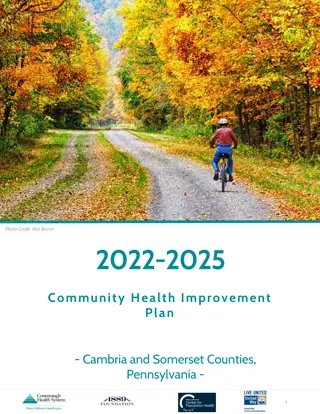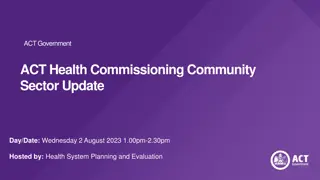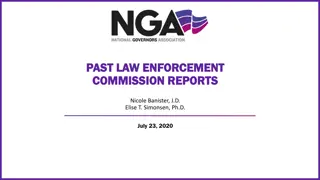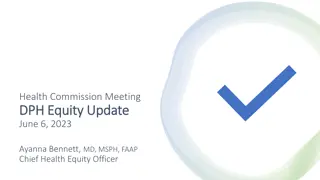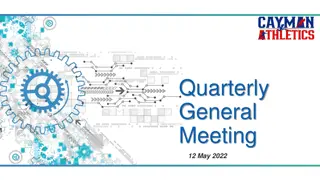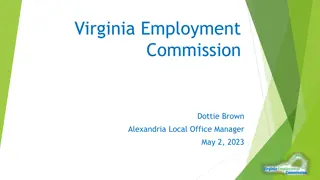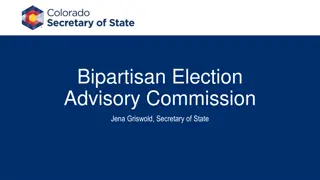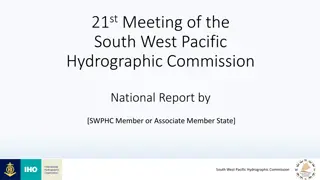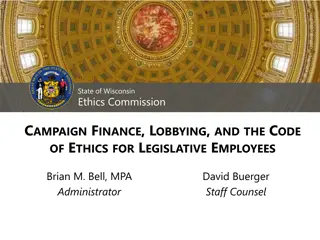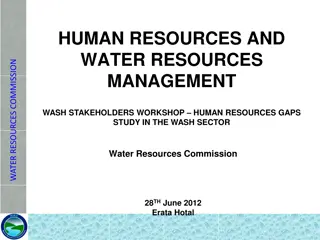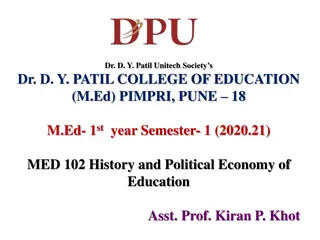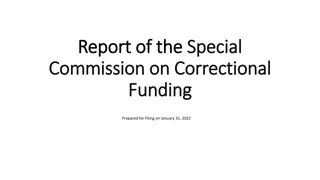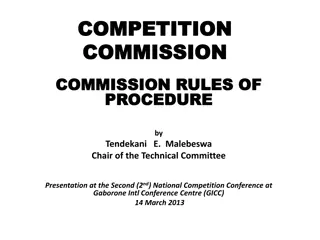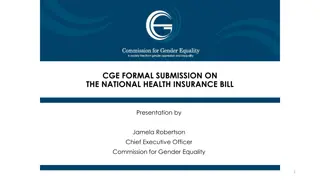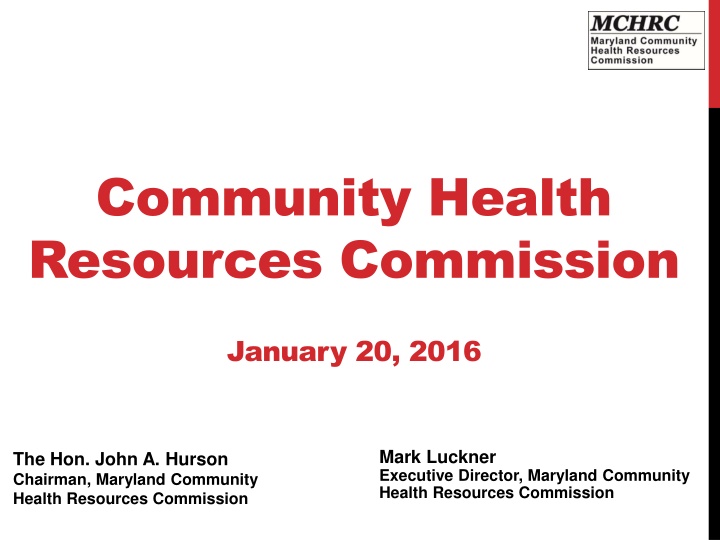
Community Health Resources Commission Overview
The Community Health Resources Commission (CHRC) in Maryland, established in 2005, focuses on improving access to healthcare for low-income individuals and underserved communities. The CHRC grants support various public health priorities, such as integrating behavioral health, reducing infant mortality, and expanding access to dental care. With a total of 154 grants awarded since 2007, amounting to $52.3 million, the CHRC has positively impacted the lives of approximately 200,000 Maryland residents through community-based organizations.
Uploaded on | 3 Views
Download Presentation

Please find below an Image/Link to download the presentation.
The content on the website is provided AS IS for your information and personal use only. It may not be sold, licensed, or shared on other websites without obtaining consent from the author. If you encounter any issues during the download, it is possible that the publisher has removed the file from their server.
You are allowed to download the files provided on this website for personal or commercial use, subject to the condition that they are used lawfully. All files are the property of their respective owners.
The content on the website is provided AS IS for your information and personal use only. It may not be sold, licensed, or shared on other websites without obtaining consent from the author.
E N D
Presentation Transcript
Community Health Resources Commission January 20, 2016 Mark Luckner Executive Director, Maryland Community Health Resources Commission The Hon. John A. Hurson Chairman, Maryland Community Health Resources Commission
BACKGROUND ON THE CHRC BACKGROUND ON THE CHRC The Community Health Resources Commission (CHRC) was created by the Maryland General Assembly in 2005 to expand access for low-income Marylanders and underserved communities. Statutory responsibilities include: Increase access to primary and specialty care through community health resources Promote community-hospital partnerships and emergency department diversion programs to prevent avoidable hospital utilization Facilitate the adoption of health information technology Promote long-term sustainability of community health resources as Maryland implements health care reform 2
BACKGROUND ON THE CHRC BACKGROUND ON THE CHRC The CHRC grants have focused on the following public health priorities: Integrating behavioral health Reducing infant mortality Investing in health information technology Promoting ED diversion programs Expanding primary care access Addressing childhood obesity Increasing access to dental care Building safety net capacity 3
BACKGROUND ON THE CHRC BACKGROUND ON THE CHRC Eleven Commissioners of the CHRC are appointed by the Governor. Below is a listing of the CHRC Commissioners (one vacancy). John A. Hurson, Chairman Nelson Sabatini, Vice Chairman Elizabeth Chung, Executive Director, Asian American Center of Frederick Charlene Dukes, President, Prince George s County Community College Maritha R. Gay, Executive Director of Community Benefit and External Affairs, Kaiser Foundation Health Plan of the Mid-Atlantic States Region William Jaquis, M.D., Chief, Department of Emergency Medicine, Sinai Hospital Sue Kullen, Southern Maryland Field Representative, U.S. Senator Ben Cardin Paula McLellan, CEO, Family Health Centers of Baltimore Barry Ronan, President and CEO, Western Maryland Health System Maria Harris-Tildon, Senior Vice President for Public Policy and Community Affairs, CareFirst BlueCross BlueShield 4
IMPACT OF CHRC GRANTS IMPACT OF CHRC GRANTS Since 2007, CHRC has awarded 154 grants totaling $52.3 million. Most grants are for multiple program years. CHRC has supported programs in all 24 jurisdictions. These programs have collectively served approximately 200,000 Marylanders. Most grants are awarded to community based safety net providers, including federally qualified health centers (FQHCs), local health departments, free clinics, and outpatient behavioral health providers. 5
IMPACT OF CHRC GRANTS IMPACT OF CHRC GRANTS Encourage programs to be sustainable after initial seed grant funding is expended. Utilize CHRC grant funding to leverage additional federal and private/non-profit funding. $52.3M awarded to grantees $18.8M in additional resources $14.9M in private, nonprofit, or local resources $3.8M in federal resources Weinberg Foundation $250,000 to West Cecil Community Health Center CareFirst HRSA New Access Point $425,874 to Mobile Med $447,612 to Access to Wholistic. & Prod. Living 6
CHRC GRANTS IN LARGER CONTEXT CHRC GRANTS IN LARGER CONTEXT Assist ongoing health care reform efforts Build capacity of safety net providers to serve newly insured Assist safety net providers in IT, data collection, business planning Promote long-term financial sustainability of providers of last resort Support All-Payer Hospital Model and health system transformation Provide initial seed funding for community-hospital partnerships Fund community-based intervention strategies that help achieve reductions in avoidable hospital utilization Issued white paper, Sustaining Community-Hospital Partnerships to Improve Population Health (authored by Frances B. Phillips) Support population health improvement activities Align with State Health Improvement Process (SHIP) goals Build infrastructure of Local Health Improvement Coalitions 7
CHRC REAUTHORIZATION CHRC REAUTHORIZATION The Maryland General Assembly approved legislation (Chapter 328) in 2014 to re-authorize the CHRC until 2025. This vote was unanimous. CHRC has a demonstrated track record in distributing and managing public funds efficiently and holding grantees accountable for performance 47 grants, totaling $10 million, under implementation Monitored by CHRC staff of four PINS Agency overhead is 7% of its $8 million budget 8
COMMUNITY HEALTH RESOURCES COMMUNITY HEALTH RESOURCES ARE IMPORTANT IN ONGOING HEALTH ARE IMPORTANT IN ONGOING HEALTH REFORM REFORM Health insurance does not always mean access FQHCs and other community health resources may be the best option for newly insured because many non-safety net providers do not accept new patients or have long wait times Historical mission of serving low-income individuals who are impacted by social determinants and have special health and social service needs Health literacy - critical role of safety net providers Demand for health services by the newly insured dramatically outpaces the supply of providers 81% of FQHCs nationally have seen an increase in patients in the last 3 years 9
FY 2016 CALL FOR PROPOSALS FY 2016 CALL FOR PROPOSALS Key Dates: November 10, 2015 Release of Call for Proposals January 11, 2016 Applications due January/February Grant Review Period Mid-March Presentations and Award Decisions Three strategic priorities: (1) Expand capacity; (2) Reduce health disparities; and (3) Support efforts to reduce avoidable hospital utilization. 10
FY 2016 CALL FOR PROPOSALS FY 2016 CALL FOR PROPOSALS Generated 71 proposals totaling $14.8 million in year one funding (FY 2016 budget - $1 million is available) Most proposals seek funding for multiple years. Total requested this year was $31.3 million. RFP includes 4 types of projects: 1. Women s health/infant mortality - 4 proposals, $1.7M 2. Dental care - 12 proposals, $2.8M 3. Behavioral health/heroin and opioid epidemic - 20 proposals, $9.8M 4. Primary care and chronic disease management - 35 proposals, $17.0M 11
FY 2016 CALL FOR PROPOSALS FY 2016 CALL FOR PROPOSALS Review Criteria (100 point scale) (1) Addresses strategic priorities (1a) Build capacity and support implementation of the Affordable Care Act (1b) Address health disparities (1c) Reduce avoidable hospital admissions and readmissions (2) Community need (3) Project impact and prospects for success (5) Sustainability/matching funds (4) Program monitoring, evaluation, and capacity to collect/report data (6) Participation of stakeholders and partners (7) Organizational commitment and financial viability 12
CHRC BUDGET AND DEMAND BY CHRC BUDGET AND DEMAND BY COMMUNITY HEALTH RESOURCES COMMUNITY HEALTH RESOURCES Demand for grant funding exceeds CHRC s budget The Commission has funded approximately 19% of requests ($276.2M requested; $52.3M awarded) Total requests for funding $276.2M Total of grants awarded $52.3M Applications received 593 Total grants awarded 154 13
CHRC GRANTEE PRESENTATIONS CHRC GRANTEE PRESENTATIONS Traci Kodeck, Health Care Access Maryland (HCAM) David Baker, LifeBridge Sinai Hospital Access Health, ED diversion program and community-hospital partnership Targets high utilizers and offers care coordination and linkage to care Tammy Black, Access Carroll Access to care for low-income residents providing primary care, dental, and behavioral health services Promote long-term financial sustainability by leveraging other grants (CareFirst and Weinberg) and billing third party payers (Medicaid and commercial) Dr. Larry Polsky, Calvert County Health Department Healthy Beginnings program for substance using women of reproductive age Program provides counseling, prenatal care, training, and linkage to community resources Colenthia Malloy, Greater Baden Medical Services Open new health center site in Charles County; FQHC operates multiple sites in Prince George s, Charles, and St. Mary s Counties Services include: primary care, management of chronic disease, and behavioral health 14
Maryland Community Health Resources Commission: Access Health Traci Kodeck, MPH Interim-CEO, HealthCare Access Maryland And David R. Baker, DrPH, MBA Director, Ambulatory Quality, LifeBridge Health
ED Frequent User Reduction Access Health Partnership with HCAM Launched in June 2014 Embedded Care Coordinators in Sinai ED Engage patients returning with Unmanaged chronic conditions (somatic, behav, subst abuse) Ambulatory-sensitive conditions Intensive Care Coordination 3 months Home visits Address social barriers HealthCare Access Maryland (HCAM): Baltimore-based nonprofit that specializes in connecting vulnerable Maryland residents to needed social services and health- promoting resources
Our Model Develop Care Plan Follow up Assess Identify Refer 17
Impact To-Date 434 clients enrolled (Jan 11 2016) (51% of referred patients) Client profile: o 4% High-risk/super-utilizer o 37% At-risk* o 29% Low-risk o 30% Insurance only Insurance sign-up: 120clients Obtain a primary care provider: 222clients Primary care appointments kept: 73% 18
Impact To-Date (cont.) Estimated Avoided Utilization To-Date Comparing 4 months pre-enrollment with 4 months post case closed At-Risk Clients with Cases Closed through 9/10/15 78% have 0 visits in the first month post case closed 65% have 0-1 visit 4 months post case closed Sinai Hospital % Reduction Avoided Visits 157 Average Charge/Visit $1,181 Est. Avoided Charges $185,417 ED Visits 64% Inpt Stays 80% 45 $9,935 $447,075 Total 67% $632,492 19
Lessons Learned Hospital Champion Embedded within ED Access to EMR system/Flagging System Shared Data CRISP ENS alerts Delineation by Risk Stratification 20
Sample Client Story #1 In a five-day period in July, a 54-year-old man had come to the Sinai ED three times. He was referred to an Access Health Care Coordinator. The Coordinator learned that, in addition to having a hernia, the client lacked health insurance and frequently went hungry. The Coordinator worked with the client for 6 weeks including three home visits. She connected him to Medicaid, a primary care provider, and food stamp benefits. She also helped the patient schedule hernia surgery. Since working with the Care Coordinator, the client has not visited the ED.
Sample Client Story #2 The client is a 56 year old woman who often came to the ED for non-emergency reasons, such as a stomach ache. Prior to enrollment, the client visited Sinai s ED 14 times within a 4- month period. The Coordinator met with her in the ED and the client agreed to program services. The Coordinator established a relationship with the client and arranged a new PCP, medication support, and a therapist. HCAM is in the process of obtaining a home aide. The client has followed through on her appointments to-date. Since development of her care plan, the client has returned to the ED only once.
Traci Kodeck, MPH Interim-CEO HealthCare Access Maryland TKodeck@HCAMaryland.org David R. Baker, DrPH, MBA Director, Ambulatory Quality LifeBridge Health CMS Innovation Advisor DBaker@LifeBridgeHealth.org
An Integrated, Patient-Centered, Medical Home 24
Private, nonprofit 501(c)(3) Established 2005 10 years old Private and Public Health Partnership Strategic partners with Carroll Hospital & CCHD & Partnership for a Healthier Carroll County Provide integrated medical, dental, and behavioral health Target low-income, at-risk residents high rate of chronic disease Community-based - Volunteer driven Centrally located Addressing local health access only full-time safety-net 25
Three MCHRC Grants for improving access to health care since 2007: 1. Access to Care Care Coordination 2007 Award: $100K/2 years = $479,078 leveraged cash 2. Access to Dental Care 2011 Award: $300K/3 Years = $611,767 leveraged cash 3. Capacity Expansion 2014 Award: $125K/2 Years = $184,125 leveraged cash 26
Total MCHRC Awards: $525,000 Total Leveraging thru December 31,2015 Cash: $1,274,970 In-Kind: $5 million conservatively providers, supplies, diagnostics, staffing, facility space 27
Established first RN Care Coordinator in county for at-risk residents (Access Coordinator hired March 2007) Model of Coordination for aligning community resources diagnostics, specialty care, medications, providers/staff Focused on Social Determinants of Health since 2007 shelter, food, clothing, phones, transportation, public assistance Overall patients served: 6,703 individuals Intensive Case Management: Average 65 monthly - 1 FTE IMPACT: Model of training and replicating Care Coordination within community and intensive case management: efficient, cost-effective, high patient satisfaction, high provider retention, reduction of disease exacerbations, reduction ED utilization & readmissions, reduction of recidivism, and healthy community International Recognition: China visited in 2014 28
Funding in response to a proposed capital expansion project 2011-2012 Initially extractions only 1 day/month capital delays 2013 Opened New Dental Clinic full time Preventive, Diagnostic, Restorative, Emergency Funding supported full time dentist and essential dental staff IMPACT: Only full-time family dental clinic in CC offering reduced cost dental care for all ages sliding fee $40 at 138% of FPL Will be only clinic accepting Medicaid for all ages Serving high number Medicaid and elderly Medicare New relationship with University of MD Dental and Hygiene School Served: 802 Individual Patients with 4,672 encounters Highest need: Extractions and Dentures Since Opening clinic 07/2013: Extractions: 4,361 Dentures: 1,147 People don t hire people who don t have teeth! Giving smiles!! 29
With imminent need to expand, three core goals: 1. Transition from solely grant and donation based revenue to accepting of insurance, targeting Medicaid recipients. Barriers: Malpractice, Volunteerism Success: MA Provider Status 2. Develop an integrated business and sustainability plan with public health partners. 3. Develop platform for FQHC application when eligible to apply as an integrated private and public hybrid model. IMPACT: Establish as premier community health safety-net provider integrated medical, dental, and behavioral health Expand as Medicaid and safety-net provider Directly address population health and local health improvement plans Achieve high quality, affordable, accessible, and collaborative health services for at-risk residents with emphasis on prevention and wellness. Model drivers: Person-centered care, social determinants of health, chronic disease management, and community health navigation 30
On behalf of the patients we serve, we thank the MCHRC for being a VISIONARY PARTNER since 2007! Visionary Partners provide philanthropic support to address community health issues through innovative and pioneering concepts. Through the generosity of our Visionary Partners, Access Carroll is a trailblazer of improved access to medical, dental, and behavioral health services for those most in need in Carroll County, Maryland. 31
Main Patient Line: 410-871-1478 Fax: 410-871-3219 Email: info@accesscarroll.org Web: www.accesscarroll.org Facebook Access Carroll Executive Director: Tammy Black tblack@carrollhospitalcenter.org 33
Healthy Beginnings Grant and Bridge to Health Grant Healthy Beginnings grant provides one-stop coordination of care for pregnant women in need of behavioral health services and payment for underfunded services In the first 1 years, 31 pregnant women have been case managed 77.4% have 7 or more prenatal visits 87.1% born >2500 grams 90.3% of babies have not required NICU care 77.4% have received contraception after delivery >450 outreach patients
The average 7-10 day NICU admission for a baby near full term costs approximately $50,000. Cost for a baby born at 28 weeks is >$250,000. Public health is public wealth. B. Franklin
Project Phoenix Case Management Assistance with insurance enrollment Referrals from Calvert Memorial Hospital Cost Savings under All Payer Model Sustainability: Increase CCHD patient visits Establish care with Behavioral Health provider Case Transportation needs Management Coordinating Behavioral Health with Primary Care Increase LARC Usage Shift to Outpatient Treatment Decrease Treatment Failures Link to Social Services
Project Phoenix RESULTS in 1st 5 Months 96 Contacts with 85 patients case managed 63.2% without return visits to ER 75.4% without hospital readmission GOALS over 3 Years 190 Case Manager contacts for behavioral health patients Reduce ER visits by 120 Reduce hospital readmissions by 60

